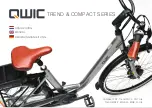
B I K E S E N S E — T H E W I S C O N S I N B I C Y C L E O P E R A T O R ’ S M A N U A L
23
Brakes work less efficiently when wet,
especially during initial exposure to wet conditions.
Black ice is particularly dangerous since it is hard to see.
It is most common on bridges, metal surfaces and shady areas.
Large vehicles traveling at high speeds create varying degrees of air tur-
bulence that can cause a bicyclist to be pulled into the path of passing
vehicles. Use extra caution to avoid being drafted (pulled) into the lane
behind a truck. Be especially cautious in windy conditions, where the
draft can be magnified by the wind-blocking action of the trailer.
Railroad tracks
Cross railroad tracks carefully. Cross as close to 90 degrees as possible
to avoid getting your wheel caught in the tracks. If the tracks cross the
road at less than 45 degrees, change your road position well in advance
so that you cross them at close to 90 degrees. Ensure that you have indi-
cated your intention to other traffic.
Watch for uneven pavement and grooves along the rails. Keep firm con-
trol of your bicycle. When crossing rough pavement or railroad tracks,
rise up from the saddle and allow your legs to act as shock absorbers.
Tracks can be slippery when wet, so avoid turns while crossing.
driver cannot see you. Avoid riding in these blind spots and only pass
slow moving large vehicles on the left.
In urban areas watch for right-turning buses and semis, since their
length and rear overhang require more space than you might expect.
Large vehicles will often move toward the left lane in preparation for
a right turn. Never pass on the right unless you have a lane to your-
self and are positive they are not preparing for a right turn. The most
dangerous point in a turn is when the cab has made the turn but the
trailer has not.
When traveling at the same speed as a transit bus requiring frequent
stops, use common sense and courtesy to avoid conflict and a poten-
tially dangerous situation between yourself and the bus that can hap-
pen when you re-pass each other. Recognize that it is often difficult
for the bus to pass you, especially in heavy traffic.
BikeSenseDaneCo-2004-04-27_Pantone543.qxd 4/27/2004 8:48 PM Page 23
















































